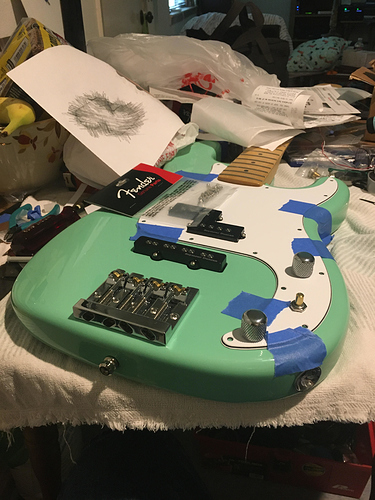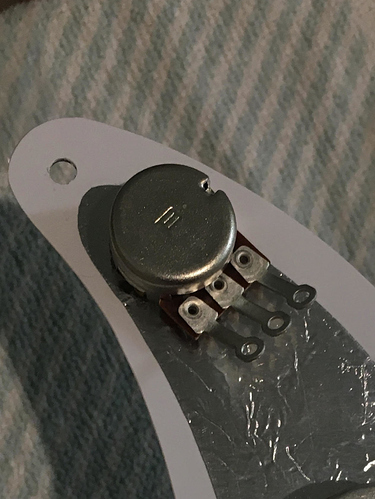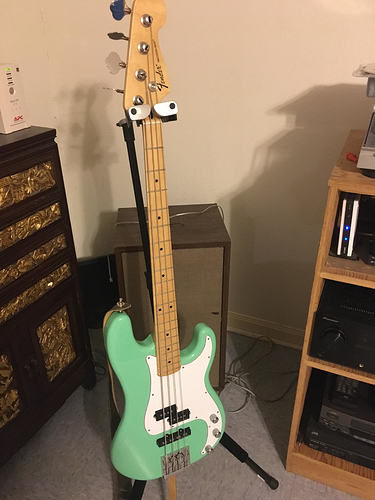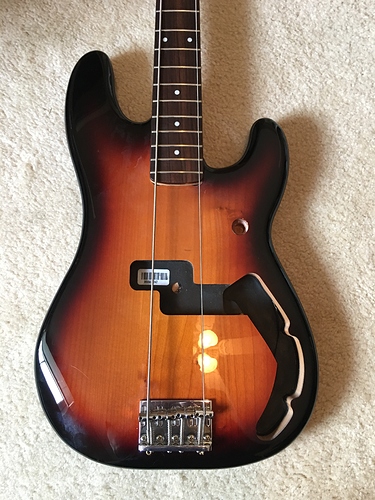Oops - had overlooked that you were going for a PJ 
Yeah, the Jazz Bass guys are snickering at me now. I can hear them…
Nah, they are just jealous they don’t have a nice P pickup 
Been very busy lately (work and personal items), but getting close with the P-bass. My wife will be glad to get the kitchen table back…
The body is DONE now. The pickgard fit very nicely; no alignment issues at all. I used a center punch to set the screws. Apparently alder is soft enough, the divit was deep enough to start the pick guard screws. The small pot worked very nicely, and the last knob should be in tomorrow. The small pot felt really good, and it was easy to flow solder to it – easier than the CTS pots which didn’t really want to take solder.
Working with the headstock now, installing the tuners. Must have been Friday when Fender made my neck, they drilled all the holes except for one. The punch mark is there, but they just didn’t drill it out. The holes are smaller than 1/16", so I’ll step down to 3/64" and see how that goes.
From there, on to the setup. I have my file set for the nut. I’ll start watching a lot of setup videos and get down to it.
You’re doing a great job. It looks like everything is coming together really well.
Thanks! Hopefully I’ll have time to pick up the drill bit this weekend and start getting finished with project.
Ready for setup! The electronics check out; here’s the P with just the E string for testing. I’m going to review all the good vids for setup. If anyone has any suggestions, I’ll be happy to watch.
A P-Bass Build Completed.
It took 8 hours for me to do the setup. Seems like a long time, and it was, but I had to be patient because it was my first time. The neck was a NOS Fender MIM P-Bass neck, and the nut wasn’t cut. It was marked where the strings went but, it would have to be filed down to set the strings. I got a nice set of files for a nice price at:
They have some pretty cool stuff there.
I really didn’t have the greatest array of measuring tools; I used card board to approximate 1 mm, etc. So, I was a bit conservative on filing the nut, because I didn’t want to over do it (go too far, you buy a new nut…and I wanted to finish today). Truss rod, bridge height, pickup height, and finally intonation-- done with the the best care I know how. The D’Adario NYXL strings are still stretching out, but a few workouts in the Bass Buzz course should fix that.
It plays pretty good. As good as the Squier for sure. After playing it for a while, I might file down the nut a bit more to get the action a bit closer, but I want to see how I like it first. I’ll probably experiment the with Squier before I do that.
Things I learned or would do differently?
-
The Fender neck and the Warmoth body could have been a bit tighter in the neck joint. I don’t know if it’s important or not, but I would have had warmer fuzzies if it did. If I do another bass build, I might consider going full Warmoth…or maybe a cheap kit so I can experiment more. The $400 body had me on high alert when I had the drill out or did anything else that screw could things up.
-
I don’t know how effective the shielding was. If you crank up the gain all the way on the J pickup, and the guitar is held a certain way, there can be some hum, but not much and only in a certain locations in the house. For sure, there’s no shielding between the pickup cavity and the control cavity: Seymour Duncan doesn’t shield their wires, for that matter, the pickup itself may be picking up the hum since the guitar had to be held a certain way to have it happen.
-
I don’t regret the Hipshot Tuners at all, even though one Hipshot HB7 costs as much as a set of Fender Highway One’s. They’re more solid, and they fit the Fender neck better with less slop.
-
@nblucas Got the Bourn pot you suggested, $2.99 at from a part suppler online. Feels great! Fits! And takes solder very nicely. The shaft is a bit longer than the CTS pots, but I just used another nut to shim the height so that the Telecaster / P-Bass nobs are all even.
-
The string tree tripped me up a bit. I tried to use the Squier as a model, but the headstock has subtle differences and the string retainer us much higher than the genuine Fender part. The Fender retainer really holds down the strings lower then my Squier. I might have moved the retainer closer to the nut, but it’s ok.
All in it’s pretty instrument in the color I wanted, and just love the feel of the neck…sooooo smooooooooth. ![]()
Multiple Bass disorder setting in? Maybe. I might like a Jazz Bass one day, and a 24 fret bass someday.
Sounds like a normal J pickup to me. I don’t like single coil J pickups for a couple reasons and this is one. What you have just found is why split coil pickups exist, it’s not your shielding ![]()
@howard Agreed. It’s not really huge deal, since the only reason I have the J is when I need to blend in a bit more attack. I have the J-pup a bit closer to the strings than the P-pup, so it’s slightly hotter, that way I won’t have to really crank up the J when I need it.
Yup, and I have a P/J now too on one of my basses, not implying it’s a bad combo. Just pointing out that this sounds more normal than anything and I don’t think you did anything wrong.
Another question, what is the use of the round hole over the electronic cavity?
Well, in my case Warmoth pre-drilled the holes for the P-pups, and they were perfectly located (thankfully).
But, before the body arrived I thought about what I would do. The way it’s put together I’d would try to mock up the pickup covers into the pick guard (with masking tape or whatever), and use something like an ice pick to locate the holes. It’s got to be straight though; lots of patience.
I am curious too!
@Dani @kwt7667 I’ve read where people have contacted Fender to ask about it and were told it’s a guide hole for orienting the wood on the CNC machine so that everything gets cut out precisely.
The funniest answers were…
It’s a tone hole.
It’s for Mojo storage.
It’s for spare change.
It’s a resonance chamber.
It’s for humidity adjustment.
It’s a reliquary.
It’s for lemon seeds.
It’s helium storage to make the instrument lighter.
It’s a cheese hole. You put cheese in it.
It’s a speed hole that makes the instrument play faster.
And finally…
You put your weed in it.
I don’t have any spare change, but this can be quite the burden!
Haha I’ll go for the Mojo storage !
Thanls Eric!
That’s funny. I Was wondering the same . my guess was for a phase switch if you wanted. Although I looked and there is no tunnel for wiring.
Makes no sense to me. If they were to put a hole in a blank of wood to pick up the blank, they would most likely put it into the body in an area in which the pockets are going to be cut, so they would remove hole put in for location when cutting the pockets.
In reality there is no need to locate these once they are clamped in a fixture, the location is stored in the machine, and there is enough stock on the body that is going to be cut all around that would compensate to any difference in the position difference between one body to the next which would only really be .01 to .02 inch
I could be wrong and they might do that, just saying it makes no sense, especially where they put it, coming from a machinist, programmer, application engineer of 32 years.
Of course there could be a reason they do it that makes no sense.
Like Joe blow did one like this so Betty Boob did one like this and now everybody does one like this.




